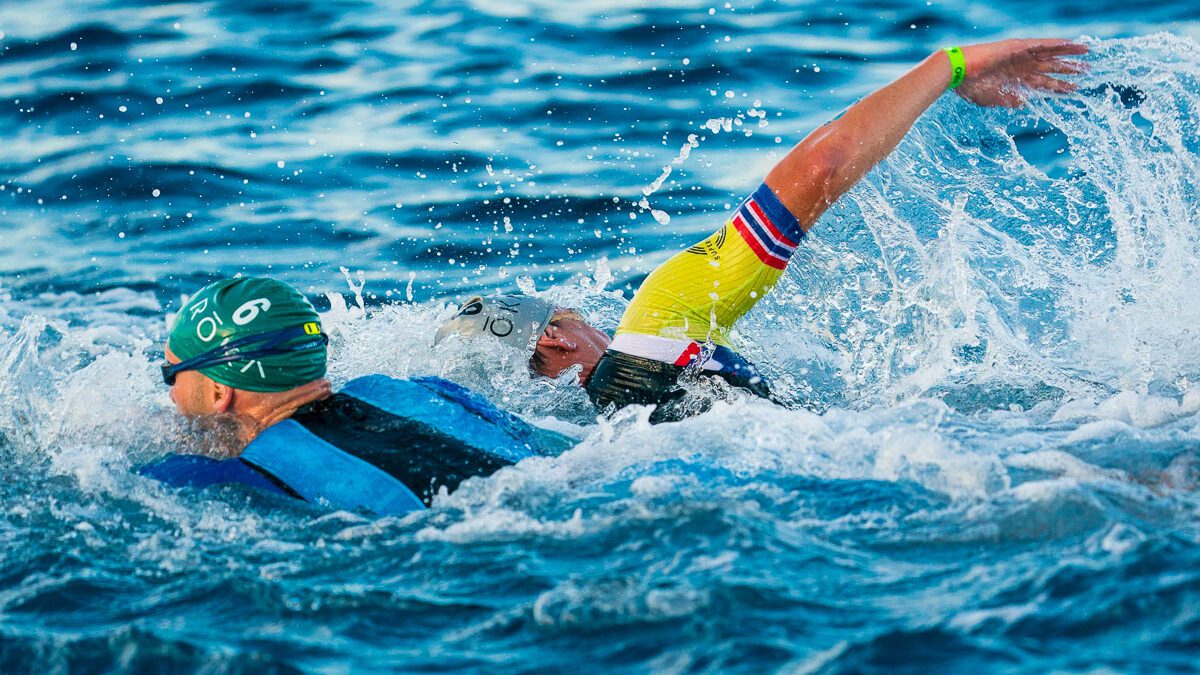Why athletes like Lionel Sanders need to improve their swim times if they want to win an Ironman World Championship
This year's race in Kona proved that to finish at the top of the podium (no matter what your level), you have to have a decent swim
 Photo by:
Kevin Mackinnon
Photo by:
Kevin Mackinnon
There’s been a few sayings floating around long course racing for as long as I’ve been in the sport, which has been a long time. Two of the most notable of those sayings are “You can’t win it in the swim, but you can lose it,” and “you run to the podium.” While mostly true, there’s many a time I questioned the former. It wasn’t uncommon for Natascha Badmann to come out of the water almost eight minutes behind the likes of Michelie Jones, only to go on to win by a couple minutes. So how much slower do you have to swim before you lose the race because of it?
If we look at this year’s Ironman World Championship race, those nuggets of wisdom seem to be holding water, as it were, but barely. I’ve always been a strong proponent of the need for fitness in the opening leg of our sport, but for the longest time I would assure athletes that they didn’t really need to be that fast–you just needed to feel good getting on the bike because that’s where the race started.
Related: Lionel Sanders to take another break from championship racing
That is simply not the case any more. If you want to win big, you need to be a triple threat. That’s been an inevitable change as the sport has evolved.
In the early days of racing you’d see guys like Wolfgang Dietrich come out of the water so far ahead of the “contenders” it seemed like they were in a different race. But no one watching ever thought those early swim and bike leaders would have any effect on the race in the end, and that’s pretty much how it always worked out. Things are a “little” different now. Those swim specialists, more often than not, are refusing to fade off.

Lucy Charles-Barkley, a former national team long-distance swimmer for Great Britain, is the obvious name on this front. Were it not for an eye-popping 2:51:44 run by Sodaro, Charles-Barclay would certainly be the Queen of Kona in 2022. So, the sayings held true, this year, anyway.
Looking back I can tell you that those early champions paid little mind to the “swimmers,” but over the last two decades things have started to change. In 1999 a young man named Tim DeBoom emerged on the pier more than 2 minutes ahead of the “contenders” – Luc Van Lierde (BEL), Canadina Peter Reid and Chris Legh (AUS).
Accompanying DeBoom was another swimmer from Germany named Andreas Niedrig. While Niedrig did what he was supposed to, fading on the run, DeBoom did something different. He held on through the bike, started the run in the lead, and did not fade. He ran a respectable 2:51 (about the same as Sodaro this past year), but Van Lierde ran almost nine minutes faster, while Reid ran 3.5 minutes faster to finish second behind the Belgian. DeBoom finished third, but it got folks talking: “If that guy figures out how to run, we’re in trouble.” DeBoom did figure out how to run.
The woman’s race in 1999 was interesting as well. Canada’s Lori Bowden swam 1:02:23, while Karen Smyers swam 53:03. Bowden took the gold, becoming the first woman to break the three-hour barrier for the marathon in Kona, while Smyers held on for second, finishing more than seven minutes back. Bowden ran her way to the podium, and most certainly did not lose the race in the swim.
Fast forward to 2022 and what we saw was a bunch of names that were left behind in the swim – and not seen again. Former champs Daniela Ryf (SUI) and Anne Haug (GER) exited the water almost seven minutes behind Charles-Barclay and, despite Ryf posting the day’s fastest bike split, she finished eighth. Haug’s sub three-hour run put her on the podium, but still looking up to Lucy.
Related: A record-setting day in Kona – the day in words and pictures
Notoriously weak swimmer (although he has improved) Lionel Saunders came out of the water over four minutes behind eventual race winner Gustav Iden and was not seen again. After the race, Sanders said that he was going to take some time off from championship racing to learn how to swim.
“You needed to be within 90 seconds of the front pack, or you were out of it,” he said
The “swimmers” are not longer likely to fade away and, as we move forward, the need to be “in” the race out of the water is going to be imperative at the highest level.
Clint Lien is the head coach of Victoria’s Mercury Rising Triathlon www.mercuryrisingtriathlon.com and asst. coach at the Canadian National Performance Centre
This story originally appeared in the November issue of Triathlon Magazine
